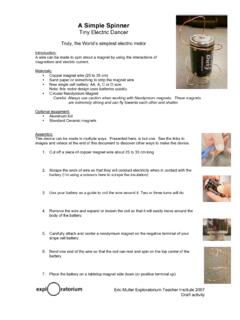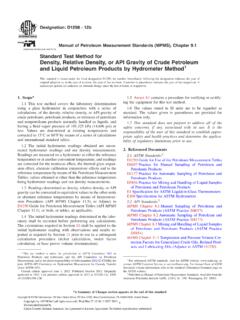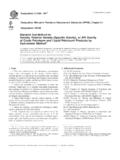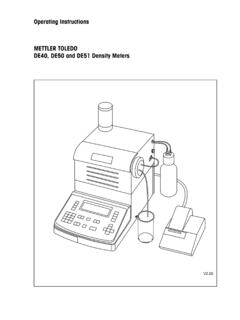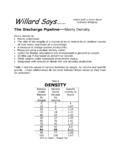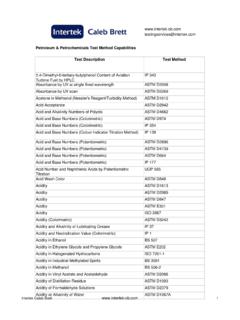Transcription of Five-Layer Density Column - exo.net
1 Five-Layer Density 1 Don Teacher Lyon St., San Francisco, CA 2005 Exploratorium, Density ColumnA Density Column consists of layers of liquids of different densities which do not mix with each other, and whichare clearly distinguishable from each other. The highest Density material is at the bottom of the Column , and asyou proceed up the Column , the Density of each successive layer decreases, with the lowest Density layer methods for construction of a Five-Layer Density Column are discussed in this write-up. All methods use thesame five liquids. Method 1 gives the names of the liquids and the order for adding them, and its goal is to directly construct thedensity Column without any experimentation. Method 2 assumes names and densities of the five materials to be unknown, and involves open-endedexperimenting, with few instructions, to construct the Column .
2 Method 3 also assumes names and densities of the materials to be unknown, and outlines a systematic wayto approach the experimentation involved in constructing the 1 Obtain a clear plastic container whose size meets your needs, and carefully add appropriate amounts of thefollowing materials in the order specified (the first material listed is the most dense, and should be added first:water -- color with an appropriate amount of food color before pouringcanola oil -- don't add food color (it won't dissolve in oil)60% isopropyl alcohol -- you can buy 70% isopropyl at drug stores and grocery stores -- it's used asrubbing alcohol and disinfectant -- you then have to dilute it to make it 60% -- add 2 ml of waterto every 10 ml of alcohol, or 20 ml of water to every 100 ml of alcohol -- before pouring, colorwith an appropriate amount of food color different from the first onemineral oil -- baby oil is mineral oil, and can be used here, but ordinary mineral oil is easily obtained atpharmacies and is cheaper -- don't add food color (it won't dissolve in oil))
3 91% isopropyl alcohol -- you can buy 91% isopropyl at most drug stores, and sometimes at grocerystores -- it's used as a disinfectant, particularly for pierced ears -- before pouring, color with anappropriate amount of food color different from the previous twoHelpful Hints: Layers should probably be a minimum of about 1/2 inch thick, and pouring should be gentle, to avoid a layerfalling through the layer it is being poured on and interacting with the layer below that one. If the container issmall, consider using a pipette or eyedropper. This is easier than pouring, and allows you to add the liquids veryslowly and gently to prevent unwanted mixing. Sometimes the material the container is made of plays a role in how well the layers form, possibly due tosurface tension effects.
4 Try tilting the container a little so that the liquid you are adding runs down the side more slowly. Or try layingthe new liquid very gently on the previous layer by having the dropper tip just barely above the liquid surface, sothat the new liquid doesn't fall and hit the surface hard. Don t use too much food coloring depending on the amount of liquid you are using, even one drop of foodcolor may be enough. If the color is too dark, you can't see through it, and it's not as 2 Treat the five materials as unknowns. Play around with them ( , experiment!) to determine which ones willallow food color dissolve in them, and the relative order of their densities. Use your results to construct thedensity Density 2 Don Teacher Lyon St.
5 , San Francisco, CA 2005 Exploratorium, 3 Students receive liquids in containers labeled A, B, C, D and E. Neither the identity or Density of any of thematerials is given. Students also receive a copy of the Data Table below (or have them draw their own ifdesired). This is what students will fill in as they experiment. (NOTE FOR TEACHERS: In addition to the blankData Table below, you will also find later in this handout a Sample Completed Data Table showing expectedresults, and a Teacher Reference Data Table showing actual substance names).Procedure use small test containers to find whether or not food coloring will mix with each of the five substances, andrecord in the data table for the liquids in which food color will dissolve, add food color to the supply BEFORE experimenting furtherwith pairs of liquids -- also see Helpful Hints for Method 1 above use small test containers to carefully mix each of the required combinations to complete the table ( , A withB, A with C, etc.)
6 -- note whether they mix or whether they form two layers -- if they mix, indicate MIX on thetable -- if layers are formed, record the letter of the substance which is on top in the upper part of the data box,and the letter of the layer which is on the bottom in the lower part of the data boxData TableSUBSTANCEABCDEFOOD COLORDISSOLVES XABCDEA X-B X XC X X XD X X X XE X X X X XFive-Layer Density 3 Don Teacher Lyon St., San Francisco, CA 2005 Exploratorium, time a substance is on the BOTTOM of a two-substance combination, give it a score of time a substance is on the TOP of a two-substance combination, give it a score of + time two substances MIX, give each a score of all combinations have been scored, add up the total score for each substance.
7 The one with the LOWEST score is the MOST DENSE, and should be added first to the Density Column . The substance with the next lowestscore should be added next, etc. (TEACHER NOTE: For more on this, see the Teacher Reference Data Table,and the detailed analysis following it.)Making the Density ColumnAdd the liquids to the Density Column in the order determined Hints: For the liquids in which food color will dissolve, add food color to the liquid BEFORE adding theliquid to the Density Column . Also see Helpful Hints noted for Method 1 INFORMATION FOR Density COLUMNSS ample Completed Student Data Table (having students include numbers is optional)SUBSTANCEABCDEFOOD COLORDISSOLVESNOYESNOYESYES XABCDEA XA (+1)B (-1)MIXD (+1)A (-1)E (+1)A (-1)B X XC (+1)B (-1)MIXMIXC X X XD (+1)C (-1)C (+1)E (-1)D X X X XMIXE X X X X XFive-Layer Density 4 Don Teacher Lyon St.
8 , San Francisco, CA 2005 Exploratorium, Reference Completed Data TableSUBSTANCEACANOLA OILBWATERCMINERAL OILD91%ALCOHOLE60%ALCOHOLFOOD COLORDISSOLVESNOYESNOYESYES XACANOLA OILBWATERCMINERAL OILD91%ALCOHOLE60%ALCOHOLACANOLA OIL Xcanola-------------------waterMIX91% alcohol-------------------canola60% alcohol-------------------canolaBWATER X Xmineral oil-------------------waterMIXMIXCMINERA L OIL X X X91% alcohol-------------------mineral oilmineral oil-------------------60% alcoholD91%ALCOHOL X X X XMIXE60%ALCOHOL X X X X XAnalysis of results shows the following:Substance A (canola oli) was on top once, and on the bottom twice; we will call this a net score of 1 Substance B (water) was on the bottom twice, for a net score of 2 Substance C (mineral oil) was on the top twice and the bottom once, for a net score of +1 Substance D (91% alcohol) was on top twice for a net score of +2 Substance E (60% alcohol) was on top once and on the bottom once, for a net score of 0 Arranging the substances in order, from most dense to least dense ( , starting with 2, and proceeding to +2,we find the order of Density to be: WATER, CANOLA OIL, 60% ALCOHOL, MINERAL OIL, 91% placed into a container in this order, with food colors added to the water and the two alcohols, a 5-layerdensity Column will be Density 5 Don Teacher Lyon St.)
9 , San Francisco, CA 2005 Exploratorium, Miscellaneous ItemsPost-Lab Question: For each of the statements below, circle T if true, or F if falsea. T Fwater mixes with alcoholb. T Fwater mixes with oilc. T Foil mixes with alcoholc. T Foils mix with each otherd. T Falcohols mix with each otherA NOTE ON HELPFUL HINTS: READING THE HELPFUL HINTS BEFORE MIXING LIQUIDS AND MAKINGTHE Column MAKES FOR A MORE EFFICIENT PROCESS WITH BETTER CHANCE FOR INITIALSUCCESS. BUT IF TRYING THINGS FIRST IS INTRIGUING, IT IS HIGHLY ENCOURAGED. THE HINTSCAME FROM ACTUAL TRIAL AND ERROR EXPERIENCES, AND IN FACT WERE GENERATED AS MUCHBY FAILURE, AND THE NEED TO FIND A BETTER TECHNIQUE, THAN BY INITIAL SUCCESS. YOU CANOFTEN LEARN A LOT FROM "FAILURE," AND IN BYPASSING IT YOU SOMETIMES LOSE SOME OF THERICHNESS OF THE EXPERIENCE.
10 ONE GOOD THING ABOUT MAKING A SMALL Column IS THAT YOUDON'T WASTE MUCH MATERIAL IF YOU BLOW IT AND HAVE TO START OVER!ReferencesSarquis, Jerry Mickey Sarquis, John P. Williams, Teaching Chemistry with Toys, TAB Books, 1995. SeeFrustration Bottles, pp. , Christie L., Lee SR. Summerlin, Chemical Activities; Teacher Edition, American Chemical Society,1998. See Layers of Liquids, pp. 27-28.

